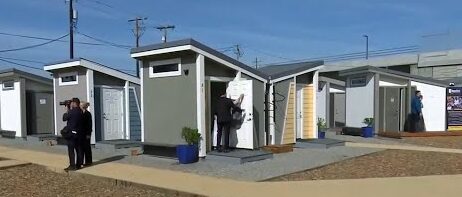Morgan Hill has its fair share of unused commercial lots and open spaces.
![]()
This editorial is the opinion of Morgan Hill Life

Tiny homes in San Jose to help the homeless find shelter.
The South Bay has seen an explosion of homeless encampments in recent years, with increasingly more of our unhoused neighbors sleeping in RVs, cars, parks, creeks, or on the streets. As heartbreaking as this crisis is to see, we’ve struggled mightily to find solutions.
That’s why the recent news out of San Jose offers hope. Prominent philanthropist John A. Sobrato has offered the city two acres of land for a lease of just $1 a year to develop tiny home communities for the homeless.
The property is located at San Ignacio Avenue and Via Del Oro in the southeast part of the city.
If approved, the city plans to build about 150 mobile tiny homes to shelter unhoused residents as well as seniors and veterans.
The Via Del Oro site is estimated to cost $18 million to develop. The homes would be solar-powered with two beds each and would be mobile, allowing them to be transported elsewhere after the five-year lease is up. Sobrato has donated $5 million to a similar tiny home project already underway in San Jose.
San Jose Mayor Matt Mahan praised Sobrato’s offer as an example of private citizens helping address the homelessness crisis. This innovative public-private partnership is exactly the kind of creative thinking we need to tackle this humanitarian crisis.
While San Jose is leading the way, we believe it presents an opportunity for Gilroy and Morgan Hill city councils to consider a similar program to help the homeless in southern Santa Clara County.
With our temperate climate and ample open spaces, there is no reason we couldn’t replicate a similar tiny home village model here. It would provide our unhoused neighbors with privacy, stability and a path off the streets. And at a fraction of the cost of traditional housing projects, it’s fiscally prudent as well.
For those unfamiliar, tiny homes are small, efficient housing units that optimize space and amenities. They typically range from 100 to 400 square feet.
What they lack in size, they make up for in efficiency and community. Tiny home villages can include shared kitchens, bathrooms, and gathering spaces that promote resident interaction.
The homes themselves include the basics — a bed, storage, electricity — as well as modern touches like solar power. While small, they provide privacy and a place to call home.
Tiny homes have taken off across the country as an innovative, affordable housing option. For the homeless, they can provide transitional stability and a bridge to permanent housing.
Unlike San Jose, the South Valley region has ample vacant land that could accommodate tiny home communities. With its rural areas and vacant industrial sites, there are opportunities to replicate San Jose’s model.
In Gilroy alone, there are more than 12,000 acres of agricultural land surrounding the city, much of it undeveloped.
And Morgan Hill has its fair share of unused commercial lots and open spaces. With community support, some of these vacant lands could temporarily house dozens of tiny homes for our unhoused population. The rural environment provides the space, and the need for transitional housing certainly exists. We have both the capacity and necessity to make this work in southern Santa Clara County.
We also encourage our well-resourced neighbors to follow John Sobrato’s lead. For those blessed with vacant land in southern Santa Clara County, please consider offering it up, even if just temporarily, to shelter the homeless and be part of the solution. With your help, we can provide emergency transitional housing with compassion.
If you own five acres of unused farmland, imagine the possibilities for sheltering families. If you have a vacant lot, it could house veterans needing support. You have the power to give a hand up.
We urge our local leaders to follow San Jose’s lead. Let’s work together with our nonprofit and private sectors to find available land for tiny home communities.
Let’s have a heart for our unhoused residents. And let’s give them a hand up by providing affordable transitional housing with compassion and dignity.
We applaud San Jose’s outside-the-box approach and urge the South Valley to follow suit. Let’s challenge our local leaders in city and county government to brainstorm innovative ideas for housing the homeless. If they hear from the public, they more likely will take action.
Collaboration between government, business, nonprofits and philanthropists is how we can make real change. The solutions won’t always be easy, but the tiny home village model offers some hope.
With compassion and creativity, we can provide transitional housing that leads to stability. Let’s lead the way in Santa Clara County’s efforts to creatively house the homeless.
The time for talk is over. The time for action is now.






